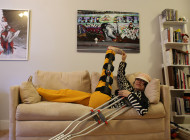October 2013: Jay was glued to the TV set. Mayam Mahmoud, an eighteen-year-old economics undergrad, had stepped onto the stage wearing a pink veil and begun to rap. Oozing anger and attitude, she tackled harassment and the blaming of victims. With that TV debut on “Arabs Got Talent,” Mahmoud challenged all stereotypes. She was an activist, a female rapper, and a Muslim woman garbed in tradition. Jay felt proud of her and reflected back on her own journey through tradition and activism.
—
Fighting Against Tradition and Through Tradition
Jay: As a sixteen-year-old teenage immigrant from India, I landed in New Orleans during the year of desegregation in the sixties. Activism and traditional context—the yin and yang of change—was all around me at this time.
I spent some months at a catholic high school, where the catholic nuns wore traditional veils and robes. They also were ahead of the feminist movement in actively encouraging us girls to become doctors and lawyers.
Some were discarding their traditional habits; several other were leaving their orders due to the conflicts between their changing personal beliefs and the teachings of the church. Activism and change came from within them; tradition was in the context. This context is continually reinforced by religious organizations, culture, family, friends, and teachers guiding how one thinks, acts and dresses. While often comforting, this context rarely encourages tension and activism. It is designed to perpetuate stability.
Activism and tradition clashed in my own life as well. My traditional context can be summarized as “good girls just don’t do that.” The concept of boyfriends and proms was out of the question, making me an oddity among my peers. In my early “American” years I wore the traditional saree just to conform to the idea of a “good girl.” This superficial symbol raised harmless but hurtful comments from some unthinking people. My anger and my sense of right also caused me to stay with some such symbols perhaps even longer than my parents intended.
Why should I switch to American symbols from my Indian ones?
Thus, in thought I was an activist. Aided by my newly found multicultural perspective and my youthful eagerness, I came to question every inconsistency in the traditional contexts of both the US and India.
Secularism—a principle for liberation or oppression?
Individual activism and tradition are both affected by the larger dialogue on what it means to be a secular country.
Take the example of the recent court case on the full-face-veil ban in France. Two Muslim women have challenged this ban insisting on their right to wear this veil. Should countries (such as France) demand a universal standard of dress that is exclusive of religious (and cultural) trappings? Does this standard apply equally to the Sheiks and the Cardinals; equally to the Muslim women and the Catholic nuns? Asking the question from the perspectives of those other countries around the world, should it then become equally reasonable for Muslim, Catholic and Hindu traditionalists to demand standards where the women all wear veils, or hijabs or ghoongats?
How do we distinguish and justify the hats worn by today’s elite in the western countries from the veils worn traditionally by the elite in other countries?
Trying to apply this fairly around the globe, this path can only lead us to more conflicts. Is it really worthwhile to insist on standardization?
The word “secular” corresponds to a jurisdictional separation between the government and religious organizations. When interpreted by countries and courts around the world (like France) as something that is exclusive of religion, it comes at a cost to individuals’ religious freedom. When interpreted as something that is inclusive of individuals with different religious beliefs, it promotes world tolerance. This latter is not an easy path from a legal perspective.
It challenges us to educate ourselves, then to dialogue around the world and define that which we all share as human beings: only that, nothing more and nothing less.
As for me, I have taken to wearing hats. I support thoughtful activism. I also enjoy every tradition and festival—Diwali, Christmas, Eid al-Fitr, Pesach, Qingming, and more.
—-
Responses from 11 and more
Joy: Issues like this always seem so fraught, maybe because of the deep tension between the personal and the political.
The authorities who devised the full-veil-ban don’t seem to realize that the absence of religious symbols is in itself symbolic, and that mandating their absence is even more so.
Really, everything is infused with power dynamics. The French government may consider itself to be”‘secular” and therefore neutral and unbiased, but it’s about as ideological as anything can be. Instead of God, the divine authority is Rationality and Universalism. I have yet to see a government or power structure free of “religion” or “ideology,” whatever you want to call it.
Monica: One of the beautiful things about being a third culture kid has been my exposure, from a young age, to people of all religious leanings and cultures.
Except that no one introduced him- or herself with, “Hey I’m Muslim/ Hindu/ Catholic and I will wear this cross/ hijab/ bindi to show everyone else how religious I am.”
There was not this activist zeal of trying to prove to broader society which religious tribe one belonged to. For me, any type of religion, atheism, or self expression is okay as long as people don’t politicize it. I think it’s wonderful to be proud and share knowledge of one’s cultural context. But I do not understand the politicization of religious symbols. The “right” to wear a hijab because it speaks as a political message against western secularism for instance. Why mix religion and politics? This in my mind is always a dangerous combination.
Stephanie: This piece for me raises fundamental, challenging, and ultimately still unresolved questions on the issue of what it is to be free and what the balance should be between the public and private. For Jay, wearing her sari in the face of a different and not always understanding culture changed that act from one motivated at first by a need to appease her parents to one of activism and self-identification. What then for other forms of cultural and religious expression?
What is one woman’s act of self-expression is another’s act of oppression.
In situations where we habituate women to hide themselves completely when in public can we, as Rousseau says, force people to be free? Even if they say it is their choice, can we say we know better?
Ultimately, I think no. Even as an atheist who believes that head and body coverings are a product of man’s desire to control women through self interested religious interpretation, I do not think you can force people to conform. As Jay said, exposure to new ideas matters. If we are an open and tolerant society that gives people of all cultures the opportunity to be exposed to ideas, ways of living and ways of thinking other than our own then I think that is how we can ensure whatever our background people are able to make real informed choices for themselves. Even if that choice is to be a nun or wear a hijab.
Monica: Politics and symbols aside, maybe I just believe that love, beauty and truth is the universal, and that all religions are a form of communicating with the divine.
—
Main article by Jay (guest contributor). Jay is an engineer and an academic who has previously been a high-tech entrepreneur for many years. Her current interests are in applying technology to enable global collaboration in design.
Contributors from 11 and more: Joy, Monica, and Stephanie
Tags: activism feminism Mayam Mahmoud multicultural race religion women's rights
























0 Comment